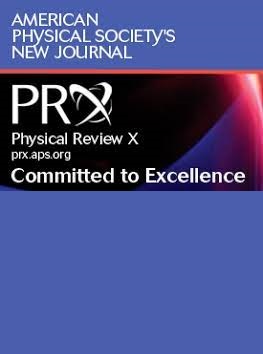压力下UTe2的不相称反铁磁性
IF 15.7
1区 物理与天体物理
Q1 PHYSICS, MULTIDISCIPLINARY
引用次数: 0
摘要
UTe2中多个超导相的发现促进了相关电子物理的研究。这种重费米子顺磁体很快被确定为研究磁性与多自由度非常规超导相互作用的参考化合物。铁磁量子相变的接近性最初被认为是三重对超导性的驱动力。然而,我们发现在压力下建立了长程不相称的反铁磁序。反铁磁相位的传播矢量km=(0.07,0.33,1)接近于以前在环境压力下观察到的反铁磁波动的波矢量。这些元素支持UTe2在环境压力下几乎是反铁磁体。我们的工作呼吁理论模拟磁相互作用和电子性质的演变,将环境压力下的相关顺磁状态驱动到压力下的远程反铁磁秩序。更深入地了解UTe2中的流动电子磁性将是描述其非常规超导相的关键。2025年由美国物理学会出版本文章由计算机程序翻译,如有差异,请以英文原文为准。
Incommensurate Antiferromagnetism in UTe2 under Pressure
The discovery of multiple superconducting phases in UTe2 boosted research on correlated-electron physics. This heavy-fermion paramagnet was rapidly identified as a reference compound to study the interplay between magnetism and unconventional superconductivity with multiple degrees of freedom. The proximity to a ferromagnetic quantum phase transition was initially proposed as a driving force to triplet-pairing superconductivity. However, we find here that long-range incommensurate antiferromagnetic order is established under pressure. The propagation vector k m = ( 0.07 , 0.33 , 1 ) UTe 2 f UTe 2 Published by the American Physical Society 2025
求助全文
通过发布文献求助,成功后即可免费获取论文全文。
去求助
来源期刊

Physical Review X
PHYSICS, MULTIDISCIPLINARY-
CiteScore
24.60
自引率
1.60%
发文量
197
审稿时长
3 months
期刊介绍:
Physical Review X (PRX) stands as an exclusively online, fully open-access journal, emphasizing innovation, quality, and enduring impact in the scientific content it disseminates. Devoted to showcasing a curated selection of papers from pure, applied, and interdisciplinary physics, PRX aims to feature work with the potential to shape current and future research while leaving a lasting and profound impact in their respective fields. Encompassing the entire spectrum of physics subject areas, PRX places a special focus on groundbreaking interdisciplinary research with broad-reaching influence.
 求助内容:
求助内容: 应助结果提醒方式:
应助结果提醒方式:


